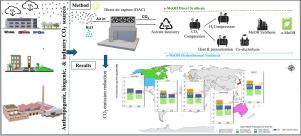Advancing e-methanol systems via direct air carbon capture, CO2 hydrogenation, and hydrothermal co-electrolysis
IF 10
1区 环境科学与生态学
Q1 ENGINEERING, ENVIRONMENTAL
引用次数: 0
Abstract
Climate change mitigation is increasingly driven by the urgent need for carbon-neutral fuels and chemicals, particularly in sectors where direct electrification is impractical. Among emerging solutions, e-methanol, synthesized from captured CO2 and green hydrogen, has been recognized as a scalable liquid energy carrier compatible with existing infrastructure. However, current system designs often evaluate carbon capture, hydrogen production, and methanol (MeOH) synthesis in isolation, with limited emphasis on integration or region-specific deployment. In this study, a novel process design, simulation model, and life cycle CO2 performance analysis have been developed for two integrated e-MeOH production pathways based on Direct Air Capture (DAC): one using direct CO2 hydrogenation (DS) and the other relying on hydrothermal co-electrolysis synthesis (HS). In both configurations, internal integrations are leveraged, such as the use of raw MeOH as an internal fuel, electrolytic oxygen reuse, and thermal integration between subsystems. The hydrothermal co-electrolysis pathway was found to outperform the direct synthesis route in both environmental and energy metrics. For a conceptual 0.3 Mt/y MeOH plant located in Japan, cradle-to-gate emissions were reduced to −0.367 kg-CO2eq/kg-MeOH for HS, compared to 0.519 for DS and 1.370 for the conventional route. Greater heat recovery further lowered energy demand. A regional sensitivity analysis indicated that in regions with low-carbon electricity (for example, in Canada), DAC-based e-methanol could achieve near-zero emissions. These findings underscore the importance of process integration and geographic energy context in determining e-methanol viability. A quantitative basis is provided to inform the scalable and regionally adaptive implementation of synthetic fuel technologies.

通过直接空气碳捕获,二氧化碳加氢和水热共电解推进e-甲醇系统
对碳中性燃料和化学品的迫切需求越来越多地推动了气候变化缓解,特别是在直接电气化不切实际的部门。在新兴的解决方案中,由捕获的二氧化碳和绿色氢合成的e-甲醇已被认为是一种可扩展的液体能源载体,与现有基础设施兼容。然而,目前的系统设计通常是孤立地评估碳捕获、制氢和甲醇合成,对整合或区域特定部署的重视有限。在本研究中,针对直接空气捕获(DAC)的两种集成e-MeOH生产途径:一种是直接二氧化碳加氢(DS),另一种是依靠水热共电解合成(HS),开发了一种新的工艺设计、仿真模型和生命周期CO2性能分析。在这两种配置中,都利用了内部集成,例如使用原始MeOH作为内部燃料、电解氧再利用和子系统之间的热集成。发现水热共电解途径在环境和能量指标上都优于直接合成途径。对于位于日本的0.3 Mt/y MeOH概念工厂,HS从起点到排放物减少到- 0.367 kg- co2当量/kg-MeOH,而DS为0.519 kg- co2当量/kg-MeOH,传统路线为1.370 kg- co2当量/kg-MeOH。更大的热回收进一步降低了能源需求。区域敏感性分析表明,在低碳电力地区(例如加拿大),基于dac的e-甲醇可以实现接近零排放。这些发现强调了过程整合和地理能源背景在确定e-甲醇可行性方面的重要性。为合成燃料技术的可扩展和区域适应性实施提供了定量基础。
本文章由计算机程序翻译,如有差异,请以英文原文为准。
求助全文
约1分钟内获得全文
求助全文
来源期刊

Journal of Cleaner Production
环境科学-工程:环境
CiteScore
20.40
自引率
9.00%
发文量
4720
审稿时长
111 days
期刊介绍:
The Journal of Cleaner Production is an international, transdisciplinary journal that addresses and discusses theoretical and practical Cleaner Production, Environmental, and Sustainability issues. It aims to help societies become more sustainable by focusing on the concept of 'Cleaner Production', which aims at preventing waste production and increasing efficiencies in energy, water, resources, and human capital use. The journal serves as a platform for corporations, governments, education institutions, regions, and societies to engage in discussions and research related to Cleaner Production, environmental, and sustainability practices.
 求助内容:
求助内容: 应助结果提醒方式:
应助结果提醒方式:


